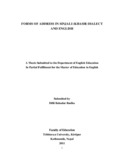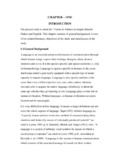Please use this identifier to cite or link to this item:
https://elibrary.tucl.edu.np/handle/123456789/3422| Title: | Forms of Address in Sinjali (Khash) Dialect and English: AComparative Study |
| Authors: | Budha, Dilli Bahadur |
| Keywords: | Languages;relation;culture |
| Issue Date: | 2011 |
| Publisher: | Department of English Education |
| Institute Name: | Central Department of Education |
| Level: | Masters |
| Abstract: | his thesis entitled “The Forms of Address in Sinjali (Khash)Dialect andEnglish: A Comparative Study”makes a comparison of theaddress forms used in the Sinjali (Khash) dialect and English. The majorobjectives of the research is to identify how the native speakers of these two(dialect and language) make choice of the forms of address, the words usedto address somebody in speech, keeping in mind various factors like age,sex, relation, social setting, culture, etc. related to addresser and addressee.The study makes a comparison on the forms of address used forconsanguineal relations, affinal relations and social relations includingstrangers, friends, teachers and students, people holding political, judicialand ecclesiastical positions, professionals like; officer, doctor, nurse,engineer and other persons in the Sinjali (Khash) community. The data werecollected from 66 native speakers of eleven VDCs ofSinja valley in Jumladistrict using stratified random sampling procedure and snowball samplingprocedure. The sources of data for the forms of address in English are basedon the previous researches carried out in the Department of EnglishEducation andencyclopedia. The researcher has found out that the Sinjali(Khash) dialect is richer in the forms of address compared to English as itcontains the forms that are not found in English. The system of addressingpeople in Sinjali and English differ in most of the cases. Usually, kinshipterms have addressive use in Sinjali (Khash) dialect but the first names (FN)are more used in English. This thesis contains four chapters: thefirst chaptercontains generalbackground, review of the related literature, objectives of the study,significance of the study and definition of the specific terms. The secondchapterrelates to the methodology, which deals with the sources of data,sample and sampling procedure, research tools, process of data collectionand limitations of the study.Likewise, thethird chapter, which is the mainpart of the thesis, comprises analysis and interpretation of the data obtained.Finally, the fourth chapter deals with the findings of the study,recommendations and pedagogical implications of the study based on thefindings. |
| URI: | http://elibrary.tucl.edu.np/handle/123456789/3422 |
| Appears in Collections: | English Language Education |
Files in This Item:
| File | Description | Size | Format | |
|---|---|---|---|---|
| cover.pdf | 47.61 kB | Adobe PDF |  View/Open | |
| chapter.pdf | 600.89 kB | Adobe PDF |  View/Open |
Items in DSpace are protected by copyright, with all rights reserved, unless otherwise indicated.
